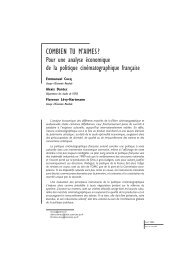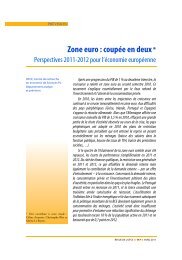direct multi-step estimation and forecasting - OFCE - Sciences Po
direct multi-step estimation and forecasting - OFCE - Sciences Po
direct multi-step estimation and forecasting - OFCE - Sciences Po
You also want an ePaper? Increase the reach of your titles
YUMPU automatically turns print PDFs into web optimized ePapers that Google loves.
Direct <strong>multi</strong>-<strong>step</strong> <strong>estimation</strong> <strong>and</strong> <strong>forecasting</strong><br />
interest, not the one-<strong>step</strong> estimated by a <strong>multi</strong>-<strong>step</strong> criterion or (iv) the gains are to be found in<br />
small samples. These assumptions are studied by other authors as we see below <strong>and</strong> will lead to<br />
the preferred approach to <strong>direct</strong> <strong>multi</strong>-<strong>step</strong> <strong>estimation</strong> which no longer aims to estimate the 1S<br />
model via <strong>multi</strong>-<strong>step</strong> techniques.<br />
4 Parametric DMS <strong>estimation</strong> under misspecification.<br />
The first contributions to the parametric approach to <strong>multi</strong>-<strong>step</strong> <strong>forecasting</strong> suggest some forms of<br />
model misspecification which could provide a sufficient rationale for the use of DMS. By parametric,<br />
it is meant that the one-<strong>step</strong> ahead parameters are the object of interest but that they are estimated<br />
by minimizing functions of the <strong>multi</strong>-<strong>step</strong> errors.<br />
Stoica <strong>and</strong> Nehorai (1989) extend the concept of <strong>direct</strong> <strong>multi</strong>-<strong>step</strong> <strong>estimation</strong> which was suggested<br />
by Findley to ARMA models:<br />
A (L) y t = C (L) ɛ t ,<br />
where A (L) = ∑ p<br />
i=0 a iL i <strong>and</strong> C (L) = ∑ p<br />
i=0 c iL i . The forecasts ŷ T +h,h are computed as the<br />
conditional expectation of y T +h given y T for the model with parameter θ = (a 0 , ..., a p , c 0 , ..., c p ).<br />
Define B h (L) = ∑ h−1<br />
i=0 b iL i <strong>and</strong> D h (L) = ∑ p<br />
i=0 d iL i , such that:<br />
C (L) = A (L) B h (L) + L h D h (L) ,<br />
so that<br />
y t =<br />
(<br />
B h (L) + D h (L)<br />
A (L) Lh )<br />
ɛ t .<br />
The h–<strong>step</strong> ahead forecast error is thus given by<br />
e T +h,h = y T +h − ŷ T +h,h = B h (L) ɛ T +h .<br />
The authors define the <strong>multi</strong>-<strong>step</strong> parameter estimator as that which minimizes a function of the<br />
in-sample squared <strong>multi</strong>-<strong>step</strong> forecast errors,<br />
̂θh = argmin F (V 1,T , ..., V h,T ) ,<br />
˜θ h ∈Θ<br />
12








